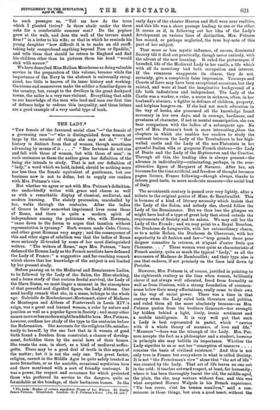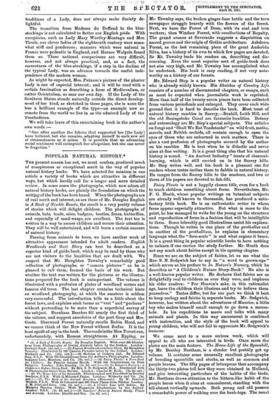THE LADY.*
"THE female of the favoured social class "—" the female of a governing race "—" who is distinguished from women at large by the number of things she may not do." " Her history is distinct from that of woman, though sometimes advancing by means of it . . . ." " Her fortunes do not rise and fall with those of women, but with those of men" : in such sentences as these the author gives her definition of the being she intends to study. That is not our definition of "lady," a word which we hold, indeed, should be nothing more nor less than the female equivalent of gentleman, but our business now is not to define, but to supply our readers with Mrs. Putnam's view.
But whether we agree or not with Mrs. Putnam's definition, she undoubtedly writes with grace and charm as well as with a remarkable display of classical, mediaeval, and modern learning. The stately procession, marshalled by her, walks through the centuries. After the ladies of Greece in their somewhat imprisoned lives come those of Rome, and there is quite a modern spirit of independence among the patricians who, with Hortensia, " came down to the forum to argue that taxation without representation is tyranny." Such women made Cato, Cicero, and other great Romans very angry ; 'and the consequence of this and other signs of rebellion was that the ladies of Rome were seriously ill-treated by some of her most distinguished writers. " The writers of Rome," says Mrs. Putnam, " have defamed the Roman Lady as the French novelists have defamed the Lady of France:" a suggestive and far-reaching remark which shows that her knowledge of the subject is not limited by her present stady.
Before passing on to the Mediaeval and Renaissance Ladies, to be followed by the Lady of the Salon, the Blue-stocking, and a home study of that curious feudal survival, the Lady of the Slave States, we must linger a moment in the atmosphere of that powerful and dignified figure, the Lady Abbess. One need hardly remark that she, in a sense, belongs to the whole age. Gabrielle de Rocheehouart-Mortemart, sister of Madame de Montespan and Abbess of Fontevrault in Louis XIV.'s reign, was a great and learned woman, a ruler by nature and position as well as a popular figure in Society ; and many other names more or less modern might be added to hers. Mrs. Putnam, however, confines her study of the type to the centuries before the Reformation. She accounts for the religious life, satisfac- torily to herself, by the one fact that in it women of good birth found a freedom from constraint, a chance of develop- ment, forbidden them by the social laws of their homes. She treats the nun, in short, as a kind of medieval suffra- gette. There may be a good deal of truth in this aspect of the matter ; but it is not the only one. The great factor, religion, cannot in the Middle Ages be quite safely treated as mere formalism, or as the amiable, occasional mysticism here and there mentioned with a sort of friendly contempt. It was a power, the respect and reverence for which protected those who preferred its service to the dangers, quite as formidable as the bondage, of their barbarous homes. In the
*. Th. Lady : Studios of certain significant Mame of her History. B• Emily lames Putnam. Illustratod. London: G. P. Putnam's Sons. PAL ed. net.)
early days of the cloister Heaven and Hell were near realities, and this life was a short passage leading to one or the other. It seems as if, in following out her idea of the Lady's development on various lines of distinction, Mrs. Putnam has missed, or perhaps neglected, the true key-note of this part of her subject.
That more or leas mystic influence, of course, dominated Society till it died out practically, though never entirely, with the advent of the new learning. It ruled the picturesque, if bounded, life of the Medieval Lady in her castle, a life which with all its monotony had both occupation and interest. If the romances exaggerate its charm, they do not, certainly, give a completely false impression. Tourneys and Courts of Love may have been exceptional occasions, but they existed, and were at least the imaginative background of a life both industrious and independent. The Lady of the Castle was a worker, a ruler, a nurse in sickness, often, in her husband's absence, a fighter in defence of children, property, and helpless bangers-on. If she had not much education in the way of books, she possessed all the knowledge found necessary in her own days, and in courage, hardiness, and greatness of character, if not in mental emancipation, she can bear comparison with the ladies of a subsequent age. No part of Mrs. Putnam's book is more interesting than the chapters in which she enables her readers to study the contrast between the Lady of the Troubadours in her high- walled castle and the Lady of the neo-Platonists in her graceful Italian villa or gorgeous French chateau—the Lady of Dante and the Lady of the ileptameron and the Courtier. Through all this, the leading idea is always present—the advance in individuality—culminating, perhaps, in the ever- attractive figure of Margaret of Navarre. After her, art becomes for the time artificial, and freedom of thought becomes pagan licence, France following—though always, thanks to inborn good taste, in more moderate measure—the social lead of Italy.
The seventeenth century is passed over very lightly, after a tribute to the original genius of Mme. de Rambouillet. This is because of a kind of literary necessity which insists that the Lady of the Salon, and nobody else, should follow the Lady of the Renaissance. But we thus lose the glimpse we might have had of a type of great lady that stood outside the requirements of Society and its salons. We may call her the Lady of the Fronde ; and we may point to a Royal Bourbon, the Duchesse de Longueville, with her extraordinary charm, or to a noble Rohan, the Duchesse de Chevreuse, with her superiority to all fashion and law—" trop grande dame pour daigner connaitre la retenue, et n'ayant d'autre freiu que l'honneur. . . ," These women were quite as characteristic of French society, quite as much the typical "Lady," as all the successors of Madame de Rambouillet ; and their type also is one that endures, if not precisely on the lines laid down by Pericles.
However, Mrs. Putnam is, of course, justified in pointing to the eighteenth century as the time when women, brilliantly clever if not always well educated, freed from formality as well as from illusions, with a strong foundation of common- sense below their many affectations, really came to their own in the way of social power. There was a time in that century when the Lady ruled both literature and politics, and ruled them all the more absolutely because—as Mrs. Putnam quotes from the brothers Goncourt—her strength lay hidden behind a light, lively, ironic sentiment and a mobile intelligence. It is very well put that such a Lady is best represented in pastel, which " carries with it a whole theory of manners, of love and life." " Manners "—here was the triumph of the Lady. Mrs. Put. nam accepts the fact as a philosopher and a student, however in principle she may belittle its importance. Whether the Lady signifies to us or not her "conception of manners . . . . remains the basis of civilised existence." And this is not only true in France but everywhere in what is called Society. It is not " the Frenchman's view " alone that "the art of life " was created by the Lady. That art of life leaves no one out in the cold : it teaches outward respect, at least, for humanity ; where it has been thoroughly learnt the old, the middle-aged, the plain, the shy, may venture without fear, and this was what surprised Horace Walpole in his French experience. " Un bon coeur, c'est les bonnes manieres," said a con- noisseur in these things, but even a good heart. without the traditions of a Lady, does not always make Society de- lightful.
The transition from Madame du Deffand to the blue- stockings is not calculated to flatter our English pride. With exceptions, such as Lady Mary Wortley-Montagu and Mrs. Thrale, our clever ladies of the eighteenth century were some- what stiff and ponderous ; manners which were natural in France were pedantic in England, and Horace Walpole found them so. These national comparisons are very difficult, however, and not always practical, and, as a fact, the earnestness of the blue-stockings, if a step in the decline of the typical Lady, was an advance towards the useful inde- pendence of the modern woman.
As might be expected, Mrs. Putnam's picture of the planter Lady is one of especial interest; and it will be read with a certain fascination as describing a form of Mediaivalism, or rather Orientalism, so near our own day. If the Lady of the Southern States stands naturally outside the direct develop- ment of her kind, as sketched in these pages, she is none the less a brilliant example of the type—an example now as remote from the world we live in as the admired Lady of the Troubadours.
We will take leave of this entertaining book in the author's own words :-
" One after another the fabrics that supported her [the Lady] have tottered, but she remains, adapting herself to each new set of circumstances as it arises. It is possible that an advancing social sentiment will extinguish her altogether, but she can never be forgotten."



























































 Previous page
Previous page